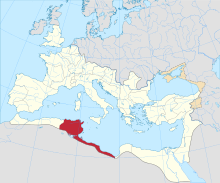
Back Africa (Romeinse provinsie) Afrikaans Africa ALS مقاطعة أفريكا Arabic Афрыка (рымская правінцыя) Byelorussian Африка (римска провинция) Bulgarian Africa (proviñs roman) Breton Àfrica (província romana) Catalan Afrika (provincie) Czech Affrica (talaith Rufeinig) Welsh Africa (romersk provins) Danish
This article includes a list of general references, but it lacks sufficient corresponding inline citations. (April 2016) |
| Africa Proconsularis | |||||||||||||
|---|---|---|---|---|---|---|---|---|---|---|---|---|---|
| Province of the Roman Republic and Roman Empire | |||||||||||||
| 146 BC–AD 439 534–698 | |||||||||||||
 The province of Africa within the Roman Empire | |||||||||||||
| Capital | Zama Regia, Utica, then Carthago | ||||||||||||
| Historical era | Classical antiquity-Late antiquity-Early Middle Ages | ||||||||||||
• Established after the Third Punic War | 146 BC | ||||||||||||
| 439 AD | |||||||||||||
• Byzantine reconquest by Vandalic War | 534 | ||||||||||||
• Reorganization into the Exarchate | 591 | ||||||||||||
| 698 | |||||||||||||
| |||||||||||||
| Today part of | Tunisia Libya Algeria | ||||||||||||
Africa was a Roman province on the northern coast of the continent of Africa. It was established in 146 BC, following the Roman Republic's conquest of Carthage in the Third Punic War. It roughly comprised the territory of present-day Tunisia, the northeast of Algeria, and the coast of western Libya along the Gulf of Sidra. The territory was originally and still is inhabited by Berbers, known in Latin as the Mauri, indigenous to all of North Africa west of Egypt. In the 9th century BC, Semitic-speaking Phoenicians from West Asia built settlements along the coast of the Mediterranean Sea to facilitate shipping. Carthage, rising to prominence in the 8th century BC, became the predominant of these.
Africa was one of the wealthiest provinces in the western part of the Roman Empire second only to Italy. It was said that Africa fed the Roman populace for eight months of the year, while Egypt provided the remaining four months' supply.[1][2][3] In addition to Carthage, other large settlements in the province were Hadrumetum (modern Sousse, Tunisia), the capital of Byzacena, and Hippo Regius (modern Annaba, Algeria).

- ^ Gadzekpo, Seth Kordzo (2002). History of African Civilisations. Rabbi Books. p. 102. ISBN 978-9988-7787-3-6.
- ^ CAH X 615
- ^ CAH XI. 812